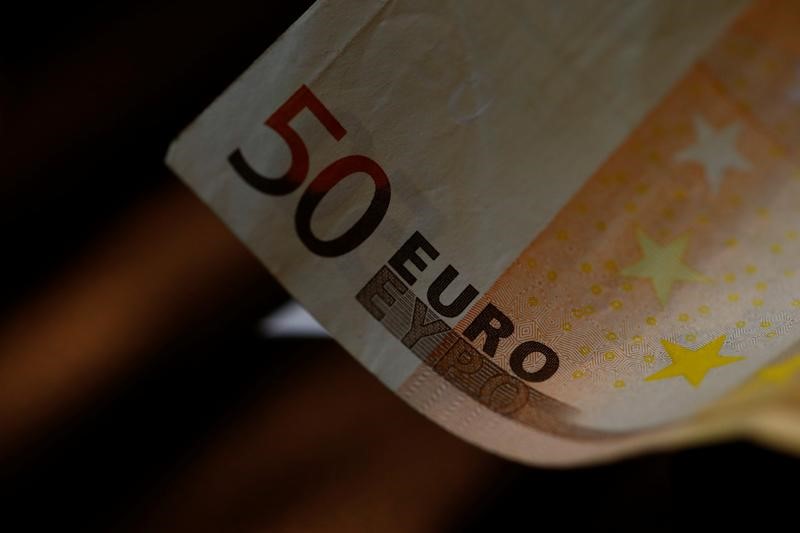* Euro climbs above $1.08 mark
* One-month euro/dollar implied vol hits six-week high
* Yen eases as new coronavirus cases subside
* Graphic: World FX rates in 2019 http://tmsnrt.rs/2egbfVh
By Ritvik Carvalho
LONDON, Feb 19 (Reuters) - The euro rose on Wednesday as
improving risk sentiment in global markets paused the dollar's
rally, providing relief to the single currency, which had
earlier fallen to three-year lows after a survey showed
weakening confidence in Germany.
The euro has fallen 3.6% to the dollar this year, as
Europe's economic data has deteriorated while that of the United
States has mostly improved.
On Tuesday, Germany's ZEW research institute said in its
monthly survey that investors' mood had deteriorated far more
than expected in February, on worries coronavirus would curtail
world trade. "I've been talking for some time about the risk of a further
downturn in euro/dollar from a fundamental point of view, based
largely on the widening difference in expected growth between
the two regions," said Marshall Gittler, head of investment
research at BDSwiss.
"There's also a technical argument to be made for a lower
euro: the single currency is approaching a major long-term
support level."
By 0844 GMT, the euro was 0.13% higher at $1.0805 EUR=EBS .
One-month euro-dollar implied volatility EUR1MO= rose to
its highest in six weeks.
But amid signs that the coronavirus outbreak is starting to
slow, global markets turned around on Wednesday. Riskier assets
-- stocks, oil and copper -- were all up.
China posted the lowest daily increase in new infections
since Jan. 29, considered an indication containment efforts were
working.
A Bloomberg report, citing sources, that China is
considering cash injections or mergers to bail out airlines hit
by the virus also supported risk appetite.
The safe-haven Japanese yen JPY= , which tends to benefit
from uncertainty, eased against the dollar to hit its lowest
level in nearly a month. It last traded 0.2% lower at 110.08 per
dollar.
The dollar index, which measures the U.S. currency against a
basket of its peers, was 0.04% lower at 99.404. .DXY
The yield curve between U.S. three-month bills and 10-year
notes inverted overnight, a bearish economic signal.
US/ Investors are looking to the minutes from the Federal
Reserve's January meeting, due at 1900 GMT, for insight into the
Fed's thinking about virus risks.
The Australian dollar AUD=D4 gained 0.15% to $0.6697,
benefiting from the risk-on mood in markets. New Zealand's
dollar also gained 0.2%. AUD/
The antipodean currencies, heavily exposed to China, have
lost more than 4.5% against the dollar this year. Norway's
krone, sensitive to global growth via oil exports, has shed 6%,
and it slumped to an 18-year low overnight NOK= .
That pushed the yen to the weaker side of 110-per-dollar and
gave a little boost to Asia's export currencies.
CNY/ EMRG/FRX
China's yuan CNY= , however, touched a two-week low after
the central bank fixed a softer-than-expected trading band, and
as investors expected further monetary
easing. "It's a tug of war between wait-and-worry and being relieved
that the infection rate is slowing down," said Bank of Singapore
currency strategist Moh Siong Sim.
"The specific moves this morning are related to more policy
help from China ... there's some relief that more help is on the
way and that is restoring some positivity to the market."
The new coronavirus has caused 2,004 deaths in China and
infected more than 74,000 people. European purchasing managers index numbers and part-month
Korean export figures, both due on Friday, are also going to be
closely watched for signs of economic impact.
The pound was flat to the dollar at $1.2993, before UK
inflation data due at 0930 GMT. The British currency gained on
Tuesday after UK finance minister Rishi Sunak announced the
budget would be presented on March 11 as planned. GBP/
<^^^^^^^^^^^^^^^^^^^^^^^^^^^^^^^^^^^^^^^^^^^^^^^^^^^^^^^^^^^
U.S. economic surprises surge as euro zone flags https://tmsnrt.rs/38FKEZR
^^^^^^^^^^^^^^^^^^^^^^^^^^^^^^^^^^^^^^^^^^^^^^^^^^^^^^^^^^^>
